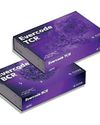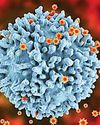
In December 2019, several cases of pneumonia of unknown etiology were reported in Wuhan, Hubei Province, China. The disease which is now called COVID-19 is caused by a novel coronavirus, severe acute respiratory syndrome coronavirus 2 (SARS-CoV-2), which was discovered through whole-genome sequencing, polymerase chain reaction (PCR) and culture of bronchoalveolar lavage fluid obtained from affected patients.
Soon after, Chinese researchers revealed that the virus is 96 per cent identical at the whole-genome level to a bat coronavirus. The researchers also announced that the virus uses a same cell entry receptor, angiotensin-converting enzyme 2 (ACE2), for its entry into the host. A spike glycoprotein found on the surface of SARS-CoV-2 is a class I fusion protein which helps the virus in its initial attachment with human ACE2 receptor and its consecutive fusion with the host cells. The attachment is mediated by the S1 subunit of theprotein via its receptor-binding domain.
Simultaneously, researchers across the globe started conducting similar studies to understand how exactly this virus is attacking the humans. Researchers also started studying the infection pattern of this virus in different countries and came out with the finding that there may be a unique mutation in the viral strain infecting the Indian population. And may be that is the reason why few countries are suffering large numbers of fatalities as compared to India.
Researchers from Taiwan and Australia have apparently found a coronavirus strain isolated in India carrying mutations in the spike protein’s receptor-binding domain (RBD) of the virus. A computer simulation shows that the RBD mutation that was not found in any other variants across the world, could remove a hydrogen bond from the spike protein. In the absence of this bond, the virus is less likely to bind to ACE2 that is found in the lungs and other organs.
Bu hikaye Bio Spectrum dergisinin May 2020 sayısından alınmıştır.
Start your 7-day Magzter GOLD free trial to access thousands of curated premium stories, and 9,000+ magazines and newspapers.
Already a subscriber ? Giriş Yap
Bu hikaye Bio Spectrum dergisinin May 2020 sayısından alınmıştır.
Start your 7-day Magzter GOLD free trial to access thousands of curated premium stories, and 9,000+ magazines and newspapers.
Already a subscriber? Giriş Yap

Sartorius Stedim Biotech opens new centre for bioprocess innovation in US
Sartorius Stedim Biotech, a leading partner of the biopharmaceutical industry, has opened its new centre for Bioprocess Innovation in Marlborough, Massachusetts in the US.

Agilent introduces innovative Mito-rOCR assay kit for mitochondrial research
Agilent Technologies Inc. has announced the new MitorOCR Assay Kit.

Qiagen launches AI-extension of Ingenuity Pathway Analysis for automatic interpretation of biological data
Qiagen has announced the launch of Ingenuity Pathway Analysis (IPA) Interpret, a new feature designed to simplify and accelerate the interpretation of complex biological data.

Parse Biosciences announces expansion of Evercode BCR product line
Parse Biosciences, a leader in scalable single cell sequencing solutions, has announced the expansion of its Evercode BCR product line to enable applications in mice.

New technology for unambiguous detection of HIV genome using tailored fluorogenic tests
A team of scientists at Jawaharlal Nehru Centre for Advanced Scientific Research (JNCASR), has developed a novel diagnostic technology known as the GQ Topology-Targeted Reliable Conformational Polymorphism (GQ-RCP) platform.

Gene mutation likely cause for developing autism in early childhood: RGCB study
Autism, a developmental disorder that causes functional abnormalities in brain development, is caused by a combination of environmental and genetic factors with its symptoms manifesting in childhood as early as the age of two years.

IIIT-Delhi unveils AI platform for discovering molecules that promote healthy ageing
A team of researchers from Indraprastha Institute of Information Technology Delhi (IIIT-Delhi) has developed AgeXtend, a groundbreaking artificial intelligence (AI)-based platform that is set to transform the search for molecules promoting healthy ageing.

RSSDI study lays focus on Yoga and Diabetes Prevention
Dr Jitendra Singh, Union Minister of State (Independent Charge) for Science and Technology, recently released the landmark study by Research Society for Study of Diabetes in India (RSSDI) on 'Yoga and Diabetes Prevention'.

Dr Alok Khullar steps in as Group CEO of RJ Corp Healthcare
RJ Corp Healthcare, a leading name in the healthcare sector through its renowned entities Cocoon Hospital and Cryoviva Stem Cell Bank, has announced the appointment of Dr Alok Khullar as Group Chief Executive Officer (CEO).

Entod Pharmaceuticals on-boards Dr Anish Desai as Scientific & Research adviser
Mumbai-based Entod Pharmaceuticals has appointed Dr Anish Desai as its Scientific and Research Adviser.